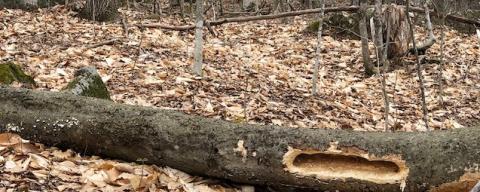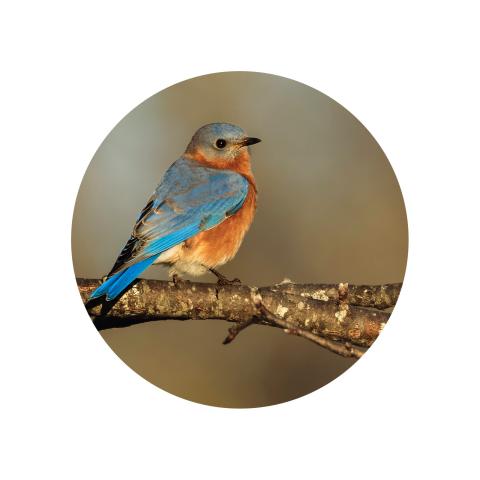Pileated Woodpeckers: How My Natural Resources Stewards Training Helped Me Finally See
I was looking out the kitchen window onto our backyard a few years ago, and I noticed something moving around the wood-and-brush pile about 30 yards from the house. My first thought was racoon because it was something substantial. As I peered and peered and got the binoculars, I realized I was totally wrong. To my great excitement, it was a pileated woodpecker—a PILEATED WOODPECKER!!!!
The pileated woodpecker for years had been on my deepest-desire-to-see list. I was thrilled. (As context, I grew up in the Northern Great Plains—largely treeless in its own wonderful way except for community plantings, shelterbelts, and natural growth along rivers.)
After the woodpecker flew off, I went out to the brush pile to see what he was so interested in. To my great surprise and burgeoning embarrassment, there was tons of evidence of many visits. A log in the pile had the tell-tale large rectangular holes drilled by pileated woodpeckers. And that led me to closer observances around the yard—another log in another location had the holes as well. And this second log was only 15 yards from the house! I remember when we put that log there—these holes were relatively recent activity.
This amazing bird that I was so desiring to see had been nearby on a regular basis over time—and I had missed it entirely. It was kind of embarrassing, but also very human and very enlightening for me personally. I was in the Natural Resources Stewards (NRS) class at the time, and I was experiencing one revelation after another about the act and art of noticing what is around us in nature. That Art of Noticing—a central part of the NRS class experience—continues to transform me.
I see—and hear and see evidence of—pileated woodpeckers regularly now. The extraordinary holes they drill dominate snags all over our property and the nearby woods. There is a shoe-box sized hole high in a big old snag visible from my living room window. I watched as one tried to drum on the hitch of a small metal trailer at the edge of our yard. I saw one drilling on a tree along the road on my route to get groceries. I see them flying overhead with what always reminds me of a pterodactyl’s profile. I now know that that jungle-sounding bird call that arrests my attention every time is a pileated woodpecker (which I NEVER would have guessed). We regularly hear the nearby drilling and drumming of what we think are pileated woodpeckers.
This act of noticing was one of the great gifts that Natural Resources Stewards (NRS) training and modeling gave to me. For some—like our leaders and speakers—noticing has been elevated to an art form. I am not there yet, but I am grateful to be a work in progress. I walked our yard with a master naturalist recently, and she was identifying fabulous plants at the wood’s edge that I myself had not really seen. There were gorgeous jack-in-the-pulpit plants; a stand of elderberry that I thought was red-osier dogwood; and various species of beautiful ferns, the variations in which I myself had not discerned. But I had previously noticed the trillium, the skunk cabbage, the sedge, and a few others. I’m getting better at noticing bit by bit.
I’m also finally understanding so much more deeply the importance of working mindfully and gently when I tackle invasives like buckthorn and bittersweet. I have in the recent past gained intrinsic satisfaction from fairly rough extraction or cutting. But I am noticing now that a single-minded ‘attack’ on invasive species can inflict a lot of collateral damage to things underfoot like the trillium or doll’s eyes, or the treasures I haven’t yet noticed.
Cheers to the Natural Resources Stewards Program for its 30 years of service to the nature of New Hampshire and to its impact on people like me, who now can better notice woodpeckers and wildlife, native wildflowers and watersheds, permaculture and woodlands; and just about everything else in entirely new and profound ways. The impact of NRS over 30 years? Extraordinary.


